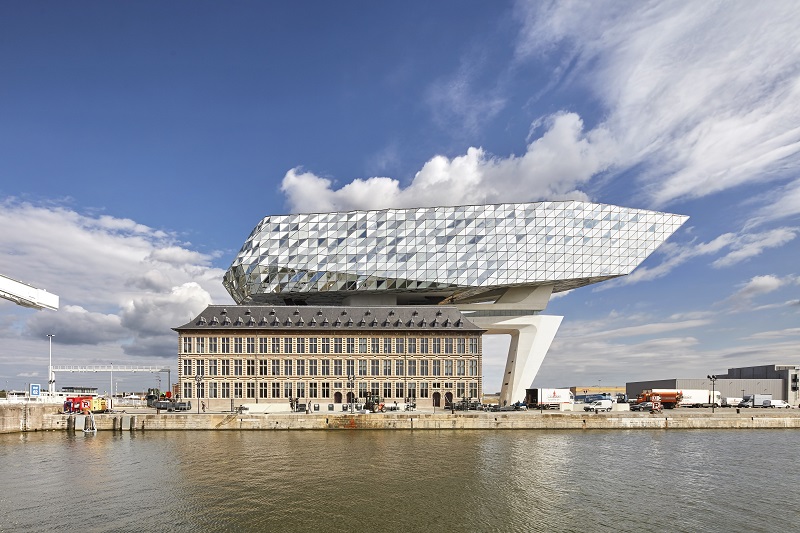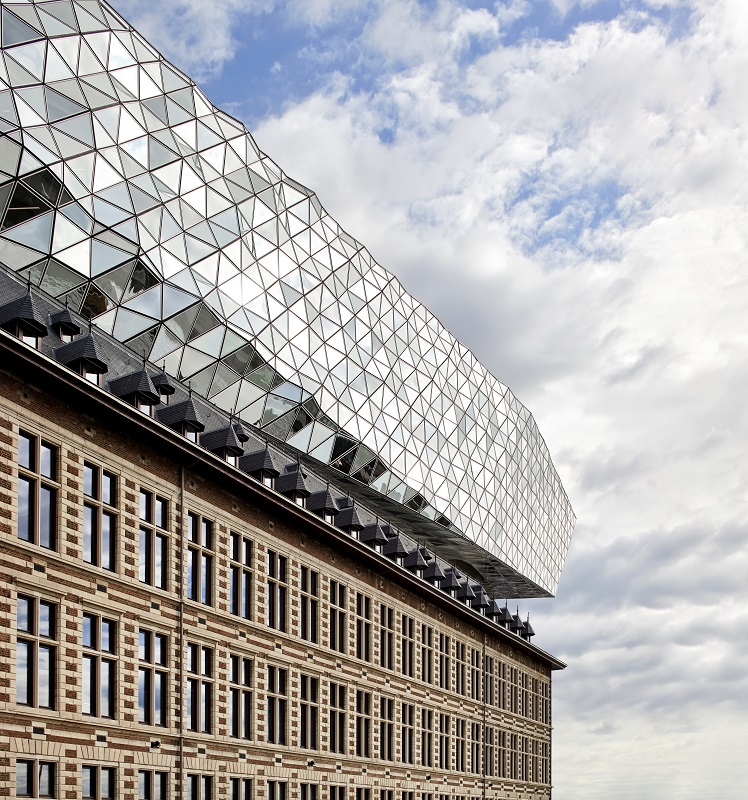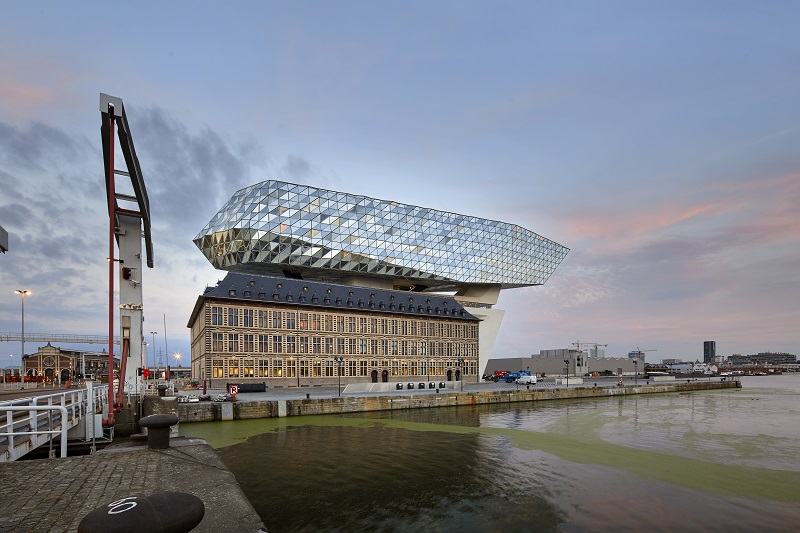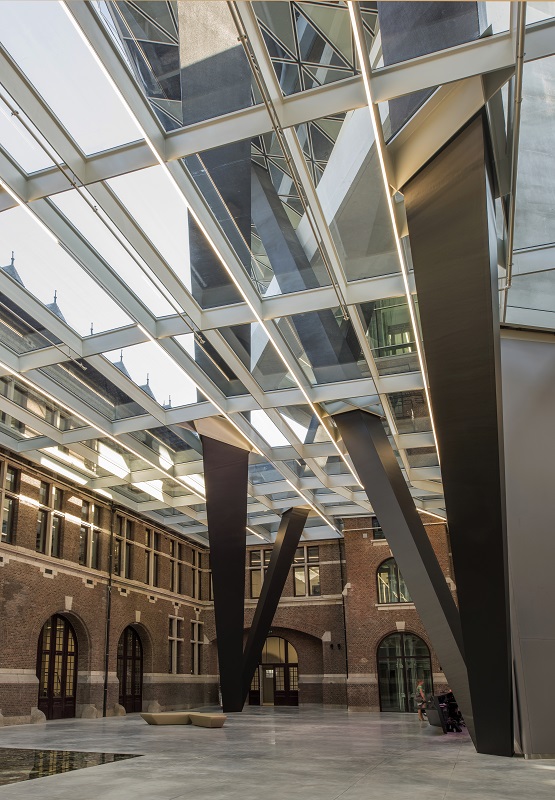Port House, Antwerp
(Image copyright Hufton + Crow)
In September 2016, the new Port House in Antwerp was completed.
Based on designs unveiled by the late Zaha Hadid in 2009, the scheme has repurposed, renovated and extended a derelict fire station to create a new headquarters for the port, which handles 26% of Europe’s container shipping and employs more than 8,000 people.
As part of the plans for the port's ambitious expansion, Zaha Hadid Architects (ZHA) proposed a new volume that would appear to float above the disused fire station, preserving the existing facades.
(Image copyright Hufton + Crow)
The huge, faceted glass volume, measuring more than 100 m in length, ripples like waves and reflects the changing tones and colours of the city’s sky. The triangular panels facilitate a transition from flat façade at the south end to a rippling three-dimensional surface at the north.
A tapered concrete leg supports one end of the glazed structure that overhangs the original dormer roof.
(Image copyright Hufton + Crow)
The mix of opaque and transparent facets ensures sufficient natural light enters the building, but also limits solar gain to optimise comfort. The idea was to provide the volume with a sparkling appearance, making reference to Antwerp’s reputation as the ‘city of diamonds’.
The central courtyard of the old fire station has been enclosed by a glass roof, and transformed into the new Port House’s main reception area. Panoramic views of the city are provided by an external bridge between the existing building and new extension.
(Image copyright Tim Fisher)
Despite the challenges presented by integration with a protected historic building, ZHA collaborated with services consultant Ingenium, to develop a sustainable and energy efficient design reaching a ‘Very Good’ BREEAM environmental rating.
A borehole energy system pumps water to a depth of 80m in more than 100 locations around the building to provide heating and cooling. In the existing building, this system uses chilled beams. In the new extension, it uses chilled ceilings. Water-less lavatory fittings and motion detectors minimise water consumption while building automation and optimal daylight controls minimise artificial lighting.
ZHA said that ‘like the bow of a ship, the new extension points towards the Scheldt, connecting the building with the river on which Antwerp was founded.’
Content and images courtesy of Zaha Hadid Architects.
[edit] Find out more
[edit] Related articles on Designing Buildings Wiki
Featured articles and news
Government consultations for the summer of 2025
A year of Labour, past and present consultations on the environment, the built environment, training and tax.
CMA competitiveness probe of major housing developers
100 million affordable housing contributions committed with further consultation published.
Homes England supports Greencore Homes
42 new build affordable sustainable homes in Oxfordshire.
Zero carbon social housing: unlocking brownfield potential
Seven ZEDpod strategies for brownfield housing success.
CIOB report; a blueprint for SDGs and the built environment
Pairing the Sustainable Development Goals with projects.
Types, tests, standards and fires relating to external cladding
Brief descriptions with an extensive list of fires for review.
Latest Build UK Building Safety Regime explainer published
Key elements in one short, now updated document.
UKGBC launch the UK Climate Resilience Roadmap
First guidance of its kind on direct climate impacts for the built environment and how it can adapt.
CLC Health, Safety and Wellbeing Strategy 2025
Launched by the Minister for Industry to look at fatalities on site, improving mental health and other issues.
One of the most impressive Victorian architects. Book review.
Common Assessment Standard now with building safety
New CAS update now includes mandatory building safety questions.
RTPI leader to become new CIOB Chief Executive Officer
Dr Victoria Hills MRTPI, FICE to take over after Caroline Gumble’s departure.
Social and affordable housing, a long term plan for delivery
The “Delivering a Decade of Renewal for Social and Affordable Housing” strategy sets out future path.
A change to adoptive architecture
Effects of global weather warming on architectural detailing, material choice and human interaction.
The proposed publicly owned and backed subsidiary of Homes England, to facilitate new homes.
How big is the problem and what can we do to mitigate the effects?
Overheating guidance and tools for building designers
A number of cool guides to help with the heat.
The UK's Modern Industrial Strategy: A 10 year plan
Previous consultation criticism, current key elements and general support with some persisting reservations.
Building Safety Regulator reforms
New roles, new staff and a new fast track service pave the way for a single construction regulator.




























